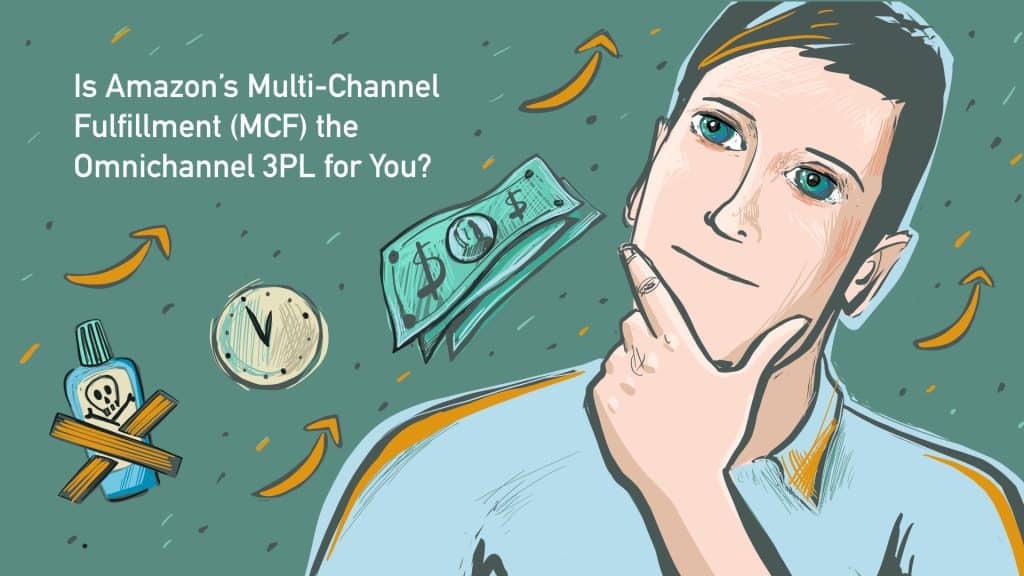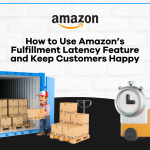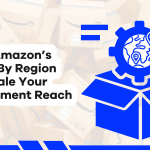
The increased interest in omnichannel ecommerce has renewed interest in Amazon’s Multi-Channel Fulfillment (MCF) service. Rather than shipping merchandise to customers on an order-by-order basis, MCF allows sellers to make bulk shipments to Amazon fulfillment centers.
Amazon fulfillment workers pick, pack, and ship these stockpiles to complete orders placed from select non-Amazon marketplaces and sales channels. If this sounds familiar, it should. MCF shares much of its DNA with Amazon’s wildly successful Fulfillment by Amazon (FBA) service.
By opening up its logistics infrastructure to off-platform sales, Amazon has positioned itself as a real contender in the third-party logistics (3PL) space. That said, Amazon’s Multi-Channel Fulfillment (MCF) is not just FBA for omnichannel ecommerce businesses.
The program has intricacies that will dictate its particular value for your business, your products, and your customers. MCF has all the trappings of an exceptional 3PL, but it has its limits.
How Does Amazon Multi-Channel Fulfillment Work?
Amazon MCF is a pretty straightforward program in concept. It is designed to remove nearly all of the seller’s fulfillment responsibilities, freeing up time and resources for other areas of ecommerce growth and brand development.
Amazon Stores Your Stock
Like with FBA (or most other 3PL services), your main fulfillment obligation is getting your merchandise to your provider—in this case, MCF. From there, you pay Amazon a storage fee based on the cubic footage of your inventory.
Being able to ship stock in bulk to the nearest Amazon warehouse can lead to significant cost and time savings compared to the burdens of shipping individual orders.
It is worth noting that you have no control over where Amazon stores your inventory once they have received it. Part of participating in MCF is allowing Amazon to make all of the decisions about where to hold your products within their network of warehouses and fulfillment centers.
Amazon Processes and Fulfills the Orders
As orders come in from your MCF-enabled sales channels, they are automatically forwarded to the Amazon warehouses, where the relevant stock is stored. Orders are then picked, packed, and shipped based on the selected shipping speed of the order.
Returns
Should a customer need to return an item that was fulfilled through MCF, you have the option of having the products returned to an Amazon fulfillment center. This is not a requirement, though. You could also opt to have the customer return the merchandise directly.
For some sellers, this may be a helpful service, while for others, it may be a feature of the MCF program that they never use. Regardless, sellers are solely responsible for customer service for their MCF orders.
Know the Costs of Multi-Channel Fulfillment
When weighing the value of Amazon MCF or any other 3PL provider, it is important to understand how the various fee structures will be applied to the products you sell and the sales volume you generate. Descartes Sellercloud’s cost of goods sold (COGS) calculations can help identify these costs and evaluate the comparative value.
Amazon charges MCF customers in three different ways:
1. MCF Requires a Monthly Subscription Fee
Just like FBA, MCF requires a subscription fee of $39.99 per month. For most sellers, this is a nominal fee, but one worth being aware of, nonetheless.
2. MCF Storage Fees
Also, like FBA, Amazon charges sellers a storage fee based on the square footage of the inventory being held. The more inventory you have in Amazon’s warehouse, the higher your storage fees will be.
It is worth noting that the oversized items can incur additional fees. There is also a general upcharge for all stored inventory during Q4. You can consult Amazon’s current storage fee rate card on your Seller Central dashboard or the Seller Central help page.
3. MCF Fulfillment Fees
Amazon MCF charges fulfillment fees based on several different factors:
- Shipping speed. Products can be shipped at standard speed (3-5 business days), expedited speed (2 business days), or priority next-day. Logically, the faster the speed, the higher the fee.
- Number of units in the order. The price for each subsequent unit in an order decreases (up to an order of 5+ units). This means that the fee for the third unit in an order is less than the second unit, which is less than the first.
- The weight of the order. The heavier the product, the higher the fulfillment fee. Amazon’s current MCF rate card has 15 different weight tiers. The most drastic increase applies to products greater than 30 lbs. These products qualify as ‘oversized’ and incur a hefty surcharge.
In addition, sellers can opt to block MCF orders from being shipped through Amazon Logistics. While some channels, such as eBay and Walmart, are open to using MCF as a fulfillment option, they are not keen on Amazon serving as the actual carrier.
Be sure to check if the channels where you sell have such a restriction, as it will add 5% surcharge to your MCF fees. Amazon increased its fulfillment fees for all MCF subscribers effective June 1, 2021. Again, the current rates and limitations can be found on Amazon’s Seller Central page.
You can also see the detailed announcement of the changes in this Amazon News post.

Pros: The Advantages of Using Amazon MCF as Your 3PL Provider
Amazon is a global ecommerce powerhouse. While fulfillment logistics may be challenging for some, it’s a cornerstone of Amazon’s success. The ability to bring Amazon on board to take order processing off your plate can free up your brand to focus on scaling in other areas.
Consolidated Inventory Makes Planning for Demand Easier
Having all your SKUs and stockpiles in one place makes it easier to deliver a unified, omnichannel fulfillment experience for your customers. As a bonus for existing FBA sellers, MCF and FBA can pull from the same inventory stockpile. This means that your existing FBA workflows can be quickly and easily parlayed into an omnichannel fulfillment plan with MCF.
Fast and Reliable Shipping Matters
Amazon has one of the most state-of-the-art fulfillment networks on the planet. Tapping into that speed and dependability can help you build and protect your ecommerce brand’s reputation.
Predictable Pricing Makes It Easy to Assess the Value of the Service
Even though the MCF rate card can seem overwhelming initially, once you know the fees associated with each SKU, the consistent pricing structure can take much of the guesswork out of evaluating your fulfillment costs.
Amazon Can Simplify Returns
If you lack a reliable returns workflow (a problem Descartes Sellercloud can remedy), MCF can alleviate some of the pain of the process. Allowing Amazon to receive returns can help get customers their replacement products or refunds quickly while preventing piles of returned dead stock from piling up in your warehouse.
Cons: The Disadvantages of Using Amazon MCF as Your 3PL Provider
Amazon Can Leverage Your Sales Data
Some have quickly criticized participating in MCF, saying that it gives Amazon an unfair peek into your brand’s sales metrics. Every transaction fulfilled by Amazon gives the ecommerce giant free market research into your customers’ buying habits and omnichannel sales performance.
Product Restrictions May Limit the Usefulness of MCF
Amazon lists prohibited items that cannot be stored or sold through its various platforms. Included in this list are also certain item categories that have their own specific restrictions. These items can technically be stored and sold but require advanced permission from Amazon and usually incur additional fees.
Even though your MCF orders are not technically being sold on Amazon’s marketplace, they are still subject to Amazon’s product limitations. If you do not comply with these regulations, your offending stock may be stranded and/or destroyed at an Amazon warehouse.
Amazon-branded Packaging
So much of cultivating an omnichannel brand comes down to establishing a complete brand image. In ecommerce, the first hands-on experience a customer has with your product is often when the package arrives.
For MCF sellers, this box is likely to be emblazoned with Amazon logos. When customers order from you from a non-Amazon channel and receive Amazon packaging, it can cause confusion. Not only that, but you have missed an opportunity to be the brand making the first impression. Amazon just stole some of your thunder.
While the Amazon MCF website says unbranded, ‘blank box’ packaging is coming for all MCF users sometime in the future (it is currently an invite-only beta program), for now, your customers will be receiving the same on-box Amazon branding on your MCF shipment as they would on any other Amazon Marketplace purchase.
This is also one of the sticking points where some ecommerce channels push back against MCF. Since all of these channels are active competitors of Amazon, many are not too keen on having their marketplace sales shipped with Amazon’s ad-covered boxes and packing tape.
Limited Sales Channel Support
That means that unless you sell solely on MCF-integrated channels, MCF cannot be used as the sole 3PL for all of your ecommerce sales. You will still need some combination of self-fulfillment and/or additional 3PL partnerships to get your orders out the door to customers.
Depending on your current and future omnichannel strategies, being beholden to Amazon’s list of approved channels may be a deal-breaker.
MCF Is Not Dropship-Friendly
Dropshipping is one of the most effective ways to transform your third-party sales into a first-party business. That said, MCF is not an ideal solution for dropshipping fulfillment. While technically possible, dropshippers would have to divulge a significant amount of account access to their partners for MCF to work as a primary 3PL.
Limited International Options
Currently, only media products (like books, music, and movies) can be shipped internationally through MCF. Other 3PLs offer more robust international shipping options, and some even offer international warehousing options.
Amazon Account Standing Matters
Since MCF is tied to your Amazon seller account, should your account be suspended or closed, you lose access to MCF services. As long as you are committed to being proactive about your standing on Amazon, this shouldn’t be an issue.
However, there is a risk in knowing that if your ability to sell on Amazon gets interrupted, your sales on your MCF channels will stall, as well.
FBA Takes Priority over MCF
It is important to note that FBA remains Amazon’s flagship fulfillment option. Some users have reported that FBA shipments take priority over MCF shipments. Under normal circumstances, this may not be an issue, but during busy seasons (or in the case of unforeseen events like a pandemic), you could experience some delays.
Alternatives to Amazon’s Multi-Channel Fulfillment (MCF)
If MCF sounds like it may not be the best fit for your ecommerce needs, some comparable services and options could:
Marketplace Fulfillment
Fulfillment by Amazon (FBA) and Walmart Fulfillment Service (WFS) are strong, reliable options for marketplace-based fulfillment. Moreover, Descartes Sellercloud’s integrations with each channel make tracking orders, managing inventory, and keeping on top of fulfillment simple.
Non-Amazon 3PL Partners
If consolidated inventory and fulfillment are a priority, there are many reputable third-party logistics providers that can give you similar features to MCF but without many of the restrictions and limitations of Amazon’s multi-channel 3PL offering.
Self-Fulfillment
Ecommerce fulfillment involves many challenges, including warehousing, picking, packing, shipping, tracking, and return processing.
Yet Descartes Sellercloud provides all the tools and support you need to manage these elements and more from a single, streamlined, cloud-based interface.
It can seem daunting, but self-fulfillment is possible and profitable if you are willing to take the plunge.
Descartes Sellercloud Helps Keep All of Your Fulfillment on Track
No matter how you handle your logistics, whether with a third-party partner, self-fulfillment, or some combination thereof, Descartes Sellercloud’s ecommerce growth platform is there to help you stay on top of it all.
Our state-of-the-art inventory management features make it easy to track all your products, monitor stock levels, and ensure your customers receive their orders. All this is done from the convenience of a single interface.
Descartes Sellercloud’s predictive purchasing features even help eliminate out-of-stocks and overselling across each channel you sell. Descartes Sellercloud also allows you to streamline your returns and RMAs (Return Merchandise Authorization), lessening the burdens on your customer service and minimizing losses.
Moreover, Descartes Sellercloud’s reporting features give you the data to evaluate how well your fulfillment workflows are performing. Analytics like COGS calculations and average order fulfillment time can identify inefficiencies and bottlenecks in your logistics.
No matter what your fulfillment plan looks like, Descartes Sellercloud’s family of products can help you achieve the next level of efficiency and reliability.
Contact us for a free demo and see the difference we can make for your omnichannel ecommerce growth.




